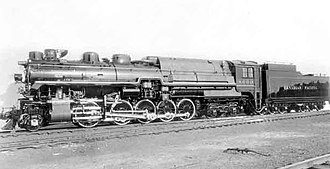CPR class T1
| CPR Selkirk locomotives | |
|---|---|
|
T1b 5927 stores oil in Edmonton
|
|
| Number: | 36 |
| Manufacturer: | MLW |
| Year of construction (s): | 1928, 1938, 1949 |
| Retirement: | 1959 |
| Type : | 1'E2 'h2 |
| Gauge : | 1435 mm ( standard gauge ) |
| Coupled axle wheel base: | 6.71 m |
| Total wheelbase: | 14.03 m |
| Wheelbase with tender: | 26.54 m |
| Service mass with tender: | approx. 335 t |
| Friction mass: | approx. 140 t |
| Top speed: | 105 km / h |
| Driving wheel diameter: | 1600 mm |
| Radiant heating surface: | 4.2 m² |
| Service weight of the tender: | approx. 130 t |
| Water supply: | 55 m³ |
| Fuel supply: | approx. 20 m³ oil |
| Control: | Heusinger control |
The Selkirk locomotives were procured by the Canadian Pacific Railway (CPR) for the route through the Selkirk Mountains in the Rocky Mountains , from which the name is derived. The Selkirks were the largest steam locomotives in Canada. The Texas locomotives had a 1'E2 ' wheel arrangement, i.e. a leading running axle , five coupling axles and a trailing bogie . The CPR procured a total of 36 locomotives in three series, all of which were built by the Montreal Locomotive Works (MLW) in the province of Québec .
| Subclass | number | number | Construction year | Serial number |
|---|---|---|---|---|
| T1a | 5900-5919 | 20th | 1928 | 67921-67940 |
| T1b | 5920-5929 | 10 | 1938 | 69110-69119 |
| T1c | 5930-5935 | 6th | 1949 | 76221-76226 |
commitment
These powerful oil-fired universal locomotives were used in front of passenger trains and freight trains on the CPR route from Calgary through the Rocky Mountains to Revelstoke . Despite their size, the locomotives had good running characteristics, only surpassed by the Royal Hudsons .
After diesel locomotives found their way onto the Rocky Mountains route in the 1950s, the Selkirks were transferred to the Brooks and Maple Creek subdivisions. On the Brook subdivision they drove eastwards from Calgary to Swift Current , and on the Maple Creek subdivision they drove north from Calgary to Edmonton . In 1957 the top speed was reduced from 105 km / h to 80 km / h.
High-pressure locomotive No. 8000
At the end of the 1930s, the high-pressure locomotive No. 8000 was built on the basis of the Selkirk locomotives. This only class T4a locomotive was unsuccessful. It was scrapped after four years of trial use.

